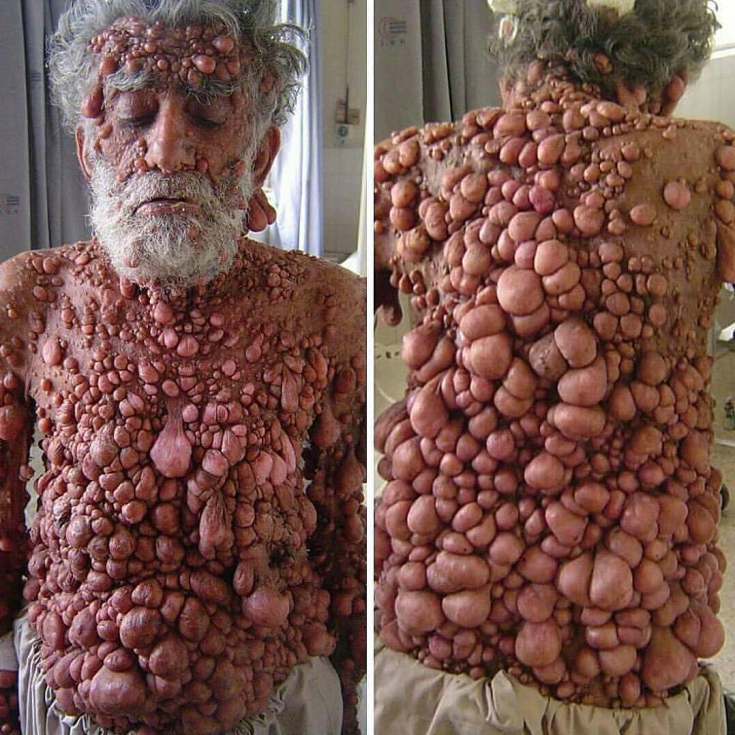Neurofibromatosis Recklinghausen – one of the most common diseases with utosomal dominant inheritance. It occurs in about 1 in 3500 newborns. Specific skin manifestations of Recklinghausen's neurofibromatosis are "café-au-lait" spots that look like freckles with well-defined borders. Histologically, they are clustered melanocytes.
Most often, skin manifestations are noted from birth or appear in the first years of a child's life, which may alert parents. They are localized, as a rule, in the armpits, inguinal regions, popliteal fossae – places of increased trauma due to friction of tight-fitting clothing.
In differential diagnosis, it is necessary to take into account the number and size of spots that increase as the patient grows older: before puberty, 5 spots with a diameter of 3-7 mm are characteristic; after puberty – 6 or more spots 13-16 mm in diameter. Find out in the material estet-portal.com, what signs will allow you to make a diagnosis of Recklinghausen's disease.
What are the additional skin manifestations of Recklinghausen's neurofibromatosis
Another specific manifestation of Recklinghausen's neurofibromatosis is the formation of benign neurofibromas, which are subdivided depending on the depth of occurrence: cutaneous, subcutaneous and plexiform.
The defeat of the specific gene neurofibromin (NF-1), which is located on the long arm of chromosome 17, disrupts the control of cell proliferation of neuroectodermal origin.
Skin neurofibromas are formed on the distal branches of the cutaneous nerves, rise above the surface of the skin, causing a cosmetic defect. Due to their localization, they are subject to high traumatization. Subcutaneous neurofibromas develop on more proximal cutaneous nerves and are typically tender to palpation.
Plexiform or proximal neurofibromas may form on deep-seated nerve plexuses and invade muscles, bones, and internal organs. The latter can transform into malignant neurofibrosarcomas.
Follow us on Telegram
What are the extracutaneous manifestations of Recklinghausen's neurofibromatosis
Lish's nodules play an important role in diagnostics – pigmented hamartomas of the iris, which can be identified by a slit lamp.
Musculoskeletal disorders include: sphenoid wing dysplasia, pseudoarthrosis of the distal epiphysis of the tibia and radius, thoracic scoliosis with meningocele formation.
According to statistics, 1 person per 3,000 of the population suffers from neurofibromatosis of the Recklinghausen type with an autosomal dominant type of inheritance.
Concomitant pathologies of neurofibromatosis of the Recklinghausen type are often glioma of the optic tract, which in 70% of patients leads to blindness, as well as hydrocephalus, rhabdomyosarcoma, leukemia, mental retardation, epilepsy, pheochromocytoma.
Read our article on pheochromocytoma: When high blood pressure indicates an adrenal tumor
Modern principles of treatment of Recklinghausen's neurofibromatosis

A specific treatment targeting the pathogenesis of Recklinghausen's neurofibromatosis is in clinical trials. There are data on the effectiveness of the farnesyl transferase inhibitor (tipifarnib), as well as in the experiment - the drug pirfenidone.
The SIOP Low Grade Glioma 2004 Benign Glioma Treatment Protocol recommends the use of cytostatics such as carboplatin and vincristine sulfate, which slow tumor growth.
Non-steroidal anti-inflammatory drugs, opioid analgesics are used in the fight against severe pain. Orthopedic surgery helps to improve the patient's quality of life. The most massive and painful neurofibromas are removed promptly.
Neurofibromatosis type I – sentence or promising field of activity
Thus, as a result of a genetic abnormality or spontaneous mutation, the control of neuroectoderm cell proliferation is disrupted, resulting in the development of neurofibromas, foci with an increased content of melanocytes and other multiple organ lesions.
Today, the prognosis is favorable and depends on the level of functioning of antitumor immunity, which, in turn, affects the degree of damage to the body and malignancy of neurofibromas. In medical treatment, cytostatic drugs come to the fore, however, clinical trials for the introduction of new drugs allow us to expect the emergence of pathogenetic therapy.
Thank you for staying with estet-portal.com. Read other interesting articles on the site in the "Dermatology" section. You may also be interested in: Blepharoplasty for neurofibromatosis: how to get a beautiful lasting result







Add a comment